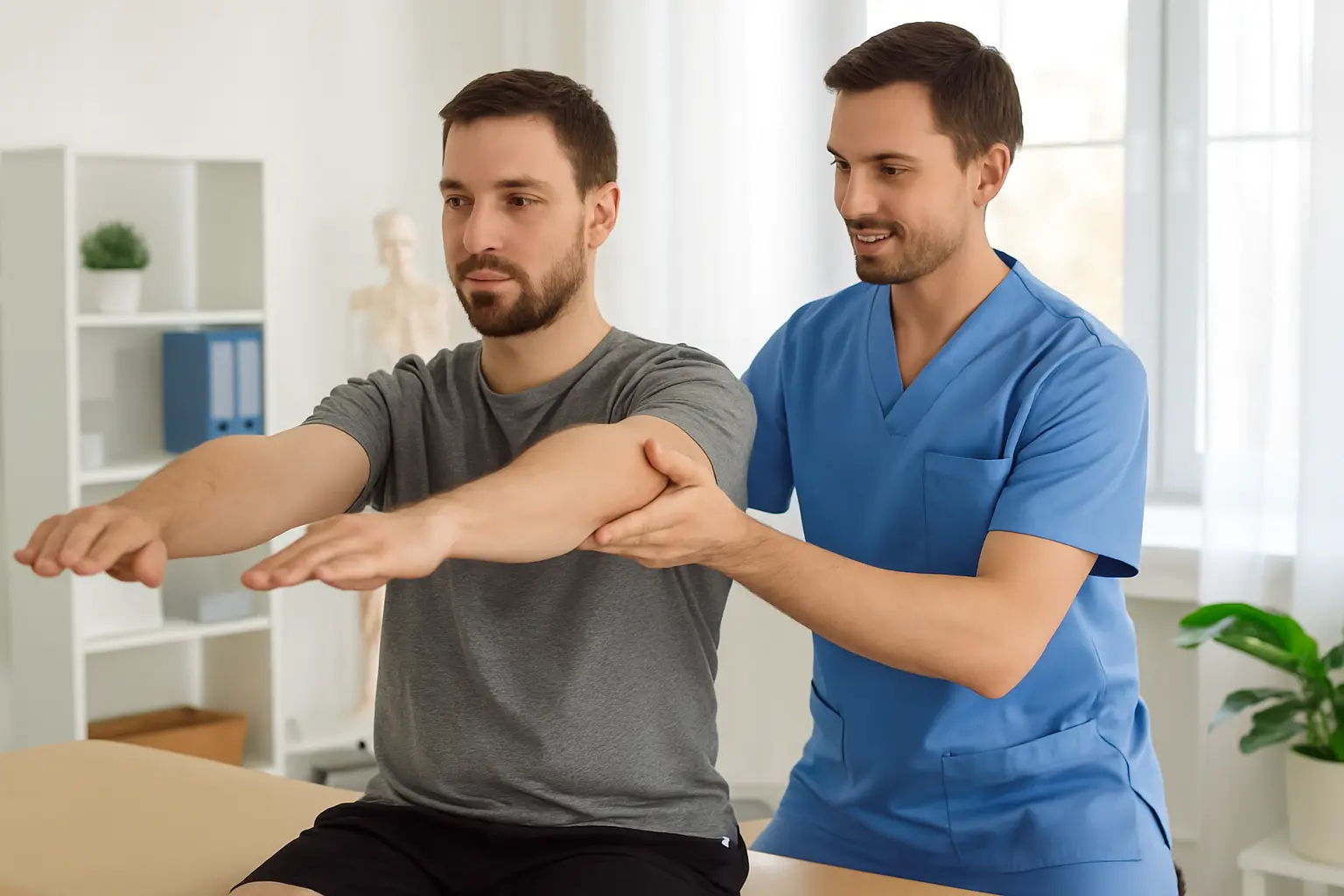
admin
September 18, 2025

Introduction
If you’re experiencing persistent pain, stiffness, or mobility issues, seeking physiotherapy Ampang services at Synapse Physiotherapy can help restore your movement and quality of life. Our physiotherapy Ampang clinic delivers personalised and evidence-based care, specialising in treating a wide range of musculoskeletal, neurological, and post-surgical conditions. Whether you’re recovering from an injury or dealing with chronic pain, early physiotherapy Ampang intervention can make a significant difference in your recovery.
At our physiotherapy Ampang facility, experienced physiotherapists conduct thorough assessments to determine the root cause of your symptoms. From lower back pain to sports injuries, we offer customised treatment plans that target your specific condition, improve function, and prevent future complications. Our physiotherapy Ampang practice sees patients of all ages and activity levels, ensuring every individual receives professional care in a welcoming environment.
This article highlights common conditions treated at our clinic and how physiotherapy Ampang services can effectively manage these health issues.
Lower Back and Neck Pain Treatment
Back and neck pain remain the most frequently reported complaints amongst adults seeking physiotherapy Ampang services. These conditions can result from poor posture, sedentary lifestyles, muscle imbalances, disc issues, or injuries. Our physiotherapy Ampang treatment typically includes:
Manual therapy to relieve joint stiffness and muscle tightness
Core strengthening and posture correction exercises
Ergonomic education for better spine health
Dry needling or myofascial release when appropriate
Our goal is to reduce pain, restore spinal mobility, and prevent recurrence through guided therapeutic programmes.
Sports Injury Rehabilitation
Whether you’re a professional athlete or weekend warrior, sports injuries require expert physiotherapy Ampang management. Common injuries include:
Ankle sprains
ACL tears
Tennis elbow
Rotator cuff injuries
Muscle strains and ligament sprains
Our physiotherapists use functional assessments and sports-specific rehabilitation protocols to ensure safe return to play. Treatment may involve:
RICE (rest, ice, compression, elevation) techniques in acute phase
Strength and conditioning exercises
Biomechanical correction
Taping or bracing support during recovery
Post-Surgical Rehabilitation Services
After surgery, targeted physiotherapy Ampang rehabilitation supports recovery from:
Total knee or hip replacement
Spinal surgeries
ACL reconstruction
Rotator cuff repair
Fracture fixation surgeries
We provide phased rehabilitation focusing on pain management, restoring range of motion, rebuilding strength, and ensuring full return to normal function. The goal is helping patients regain independence as efficiently and safely as possible.
Stroke and Neurological Conditions
Neurological conditions can significantly affect movement, coordination, and independence. Our physiotherapy Ampang specialists offer therapy for:
Stroke
Parkinson’s disease
Multiple sclerosis
Bell’s palsy
Peripheral neuropathy
Neuro-rehabilitation Treatment Approach
Neuro-rehabilitation at our physiotherapy Ampang centre includes:
Gait training
Balance and coordination exercises
Strengthening weak muscles
Functional retraining for daily tasks
Sensory stimulation techniques
We emphasise patient-centred recovery, aiming to maximise functional abilities and improve quality of life.
Shoulder and Rotator Cuff Disorders
Shoulder pain can arise from impingement, tendonitis, frozen shoulder, or rotator cuff tears, limiting arm movement and impacting daily tasks. Our physiotherapy Ampang treatment approach includes:
Joint mobilisation techniques
Range of motion exercises
Strengthening rotator cuff and scapular muscles
Therapeutic ultrasound or electrical stimulation
Postural retraining
A physiotherapist helps restore shoulder mobility whilst addressing underlying biomechanical issues that caused the condition.
Knee Pain and Arthritis Management
Knee problems are common across all age groups. From acute injuries like meniscus tears to chronic conditions such as osteoarthritis, physiotherapy Ampang services offer effective non-surgical management. Treatment at our clinic may include:
Strengthening of quadriceps and hip muscles
Stretching of tight structures (IT band, hamstrings)
Patellar tracking correction
Gait re-education
Weight management guidance for load reduction
For arthritis patients, physiotherapy helps reduce stiffness, improve movement, and delay the need for surgery.
Sciatica and Nerve-Related Pain
Sciatica, caused by irritation or compression of the sciatic nerve, results in sharp pain radiating from lower back to legs. Our physiotherapy Ampang treatment focuses on:
Nerve gliding exercises
Core and pelvic stability training
Postural correction and spinal decompression techniques
Manual therapy to relieve pressure on nerves
Our physiotherapists work closely with patients to address nerve symptoms and avoid further aggravation.
Temporomandibular Joint (TMJ) Dysfunction
Jaw pain, clicking, and restricted mouth opening may indicate TMJ dysfunction. Whilst often overlooked, physiotherapy Ampang services can provide significant relief through:
Soft tissue mobilisation around jaw and neck
Exercises to improve jaw alignment and control
Relaxation and breathing techniques
Postural adjustments to relieve strain
Treatment helps reduce pain and restore full jaw movement.
Paediatric and Developmental Delays
Children with motor delays, cerebral palsy, or muscular dystrophy can benefit from early physiotherapy intervention. Our paediatric programmes are designed to:
Enhance muscle tone and coordination
Support developmental milestones
Improve balance and posture
Educate parents on home exercises and play-based therapy
Therapy is made fun, engaging, and child-focused to encourage participation and consistent progress.
Postural Problems and Ergonomic Strain
With modern lifestyles dominated by screens and prolonged sitting, many patients suffer from postural syndromes and repetitive strain injuries. Symptoms may include:
Headaches
Neck stiffness
Upper back tightness
Wrist and hand discomfort (carpal tunnel syndrome)
Our physiotherapists provide ergonomic assessments, posture correction strategies, and strengthening programmes to combat these modern-day issues.
Why Choose Our Physiotherapy Ampang Services?
At Synapse Physiotherapy, we are committed to providing exceptional physiotherapy Ampang care through:
Highly qualified and experienced physiotherapists
State-of-the-art equipment and techniques
Evidence-based, individualised treatment plans
Friendly and supportive environment
Convenient location in the heart of Ampang
We believe in empowering patients with knowledge and tools to take control of their health beyond the clinic.
Conclusion
Physiotherapy Ampang services at Synapse represent a vital healthcare resource supporting recovery, improving function, and preventing long-term disability. Our expert physiotherapists treat conditions ranging from back pain and sports injuries to post-surgical and neurological rehabilitation. Whether managing chronic pain, recovering from surgery, or seeking improved mobility, our physiotherapy Ampang team provides personalised, hands-on care.
With evidence-based treatment approaches, we aim to get you moving better, feeling better, and living better. For comprehensive physiotherapy Ampang services, contact our experienced team or learn more about physiotherapy techniques and benefits from recognised healthcare authorities.
Visit our Ampang physiotherapy clinic for professional assessment and treatment, or explore our specialised rehabilitation programmes designed for various conditions and recovery needs.
Tags :

Back & Neck Pain
- Spine & Core Rehabilitation
- Strength & Conditioning Programme
- Pain Management
- Biomechanical Assessment
- Sports Physiotherapy
- Group Class

Sports Injuries
- Strength & Conditioning Programme
- Pain Management
- Biomechanical Assessment
- Sports Physiotherapy
- Shockwave Therapy
- Group Class

Work Desk Injuries

Pre-Post-Surgical Conditions

Scoliosis & Postural Abnormalities

Neurological Conditions

Osteoarthritis & Rheumatism
Joint degeneration and inflammation happens as the human body grows older, but that does not mean our way of life degenerates as well. Relief your joint pains with a joint effort together with your physiotherapist, who will provide pain-relief treatments and prescribe exercises for your wellbeing.

Conditions Relating To Elderly
Common conditions in the older age population include hips & knee pain, back & neck pain, osteoarthritis, rheumatism, fear of falling and many more. Aging and degeneration of bodily function is inevitable, but here at Synapse, we will help you live the best of your life.










